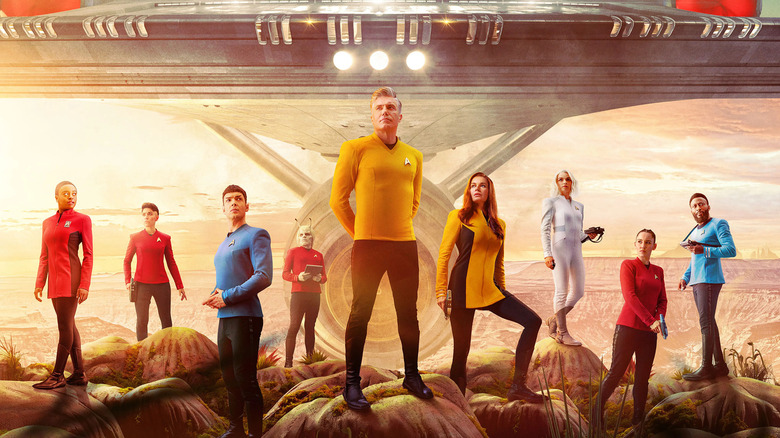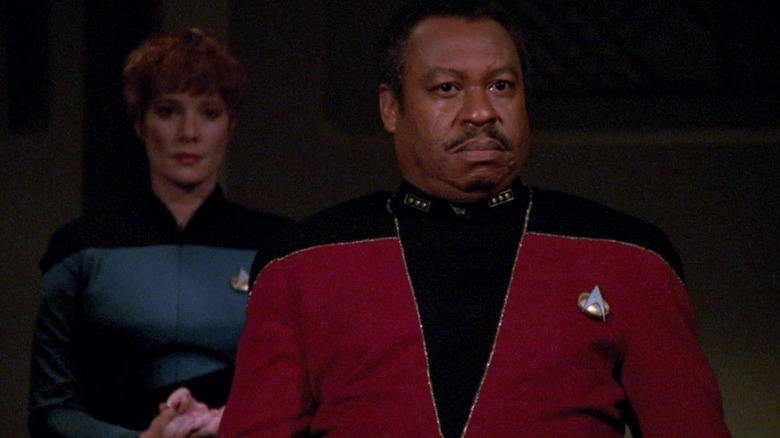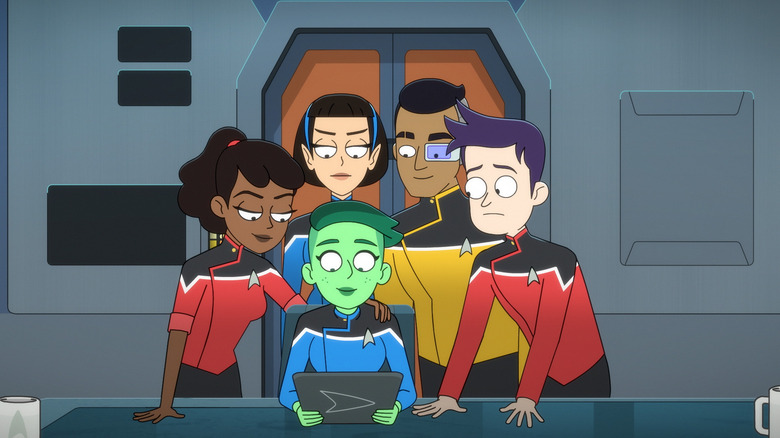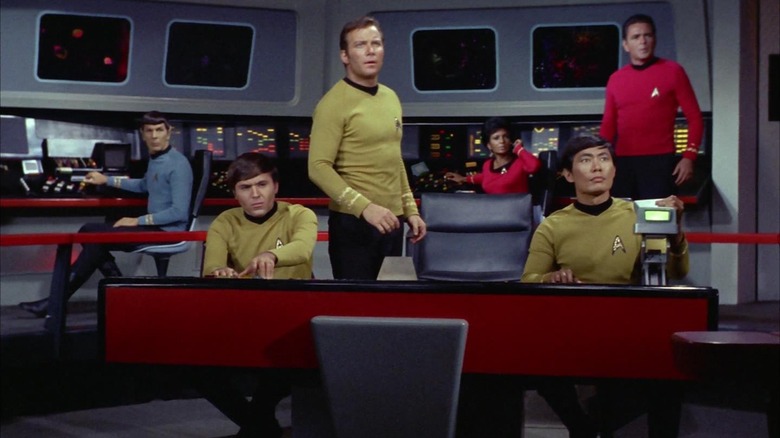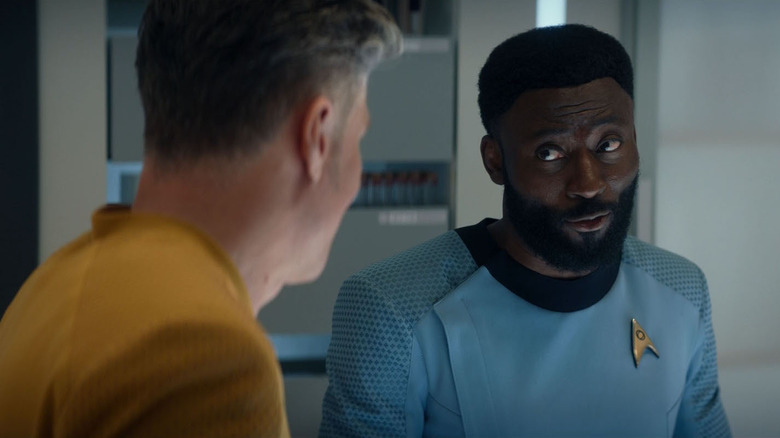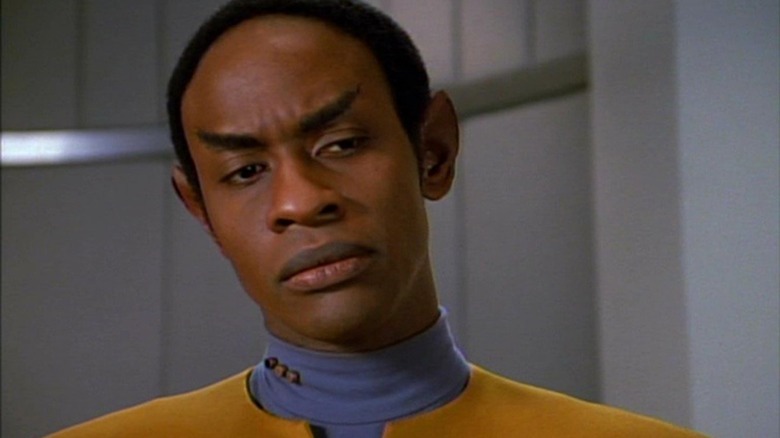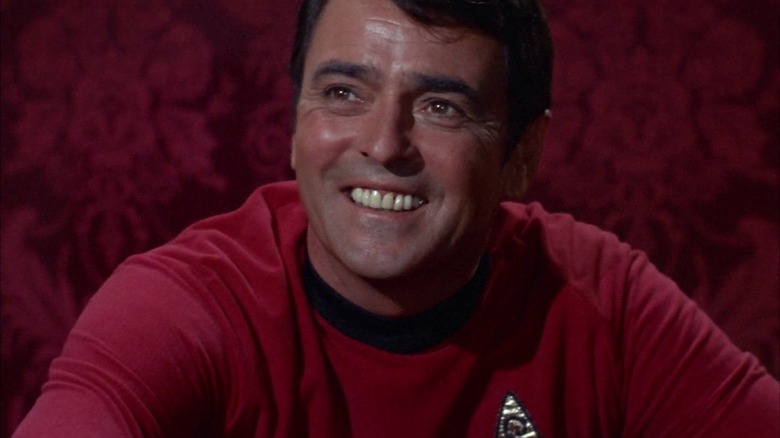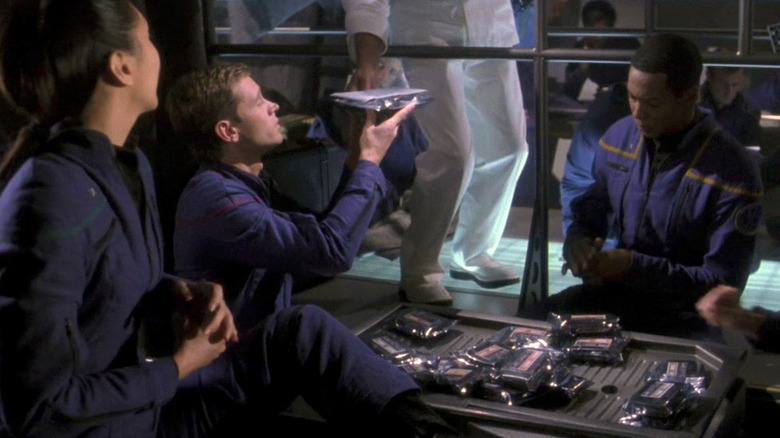Star Trek Glossary: Every Starfleet Rank And Job Explained
"Star Trek" is, first and foremost, a workplace drama. It just so happens that the workplace is a high-tech, faster-than-light space vessel exploring distant regions of the galaxy. Working on a starship is a fine job indeed. Many classic "Star Trek" episodes deal with rank, the chain of command, and how certain captains employ their unique managerial styles to inspire the officers beneath them. The main characters in "Star Trek" mostly all belong to Starfleet, a military-like organization that uses naval ranks and nautical vocabulary to describe a starship's operations.
To give the shows a touch of realism, the makers of "Star Trek" have (mostly) been careful to point out that a starship is a massively complex machine that requires hundreds of people to operate correctly. Additionally, the day-to-day logistics of running a starship require departments within departments, each one run by its own miniature team of officers, and with each team making sure that every small piece of equipment is operating at peak efficiency. Ideally, a starship can't be flown by a single person or even a scant bridge crew (I will happily ignore, however, the times that it was; those times don't count).
Trekkies take a great deal of delight in tracing and detailing the various ranks and departments on board an average Starfleet vessel, mostly because it makes it easier to imagine actually working there someday. Yes, we know it's fictional, but so much detail had gone into rank, operation, and propriety on "Star Trek" that many viewers can picture where they might be able to practically work, what their rank might be, and whom they would answer to.
For the laypeople reading, however, here is a brief rundown on the ranks, jobs, and positions one might encounter in "Star Trek."
The Starfleet ranks calling the shots
Here is the central chain of command withing Starfleet, listed from top to bottom.
At the top of Starfleet are the admirals. Admirals typically serve in official positions and don't usually command starships. They are essentially the management that starship captains have to report back to. The head of Starfleet — Commander in Chief — bears the top rank of Fleet Admiral.
Below Fleet Admirals are just regular Admirals, which are plentiful in "Star Trek."
Vice Admirals serve below them (the officer picture above bears the rank pips of a Vice Admiral), followed by Rear Admirals.
A lesson: don't trust Admirals.
We don't see too many Commodores on "Star Trek," but they are the rank in between Captain and Admiral.
Below the Commodores are Captains, who, as we all know, tend to command starships. The Captains can give orders to any officers on their ship. Captains tend to be the central characters of "Star Trek" shows, so we already know James T. Kirk, Jean-Luc Picard, Benjamin Sisko (Avery Brooks), Kathryn Janeway (Kate Mulgrew), Jonathan Archer (Scott Bakula), and, most recently Christopher Pike (Anson Mount) on "Strange New Worlds."
Directly below the Captains are Commanders. A ship's first officer is a Commander, as are a few other key figures on a ship like a Chief Medical Officer or a Counselor. Riker (Jonathan Frakes) and Spock (Leonard Nimoy) are Commanders.
Immediately below the Commanders are Lieutenant Commanders, who also tend to serve notable executive functions on a starship. People of lower ranks can indeed become members of a ship's senior staff (the "main" officers on a ship that spend the most amount of time on the bridge), but Lieutenant Commanders tend to be the lowest-ranking officers who still command their own departments on a ship.
The Starfleet ranks taking the orders
One might note that Starfleet officers wear color-coded uniforms. The colors represent the general departments in which they work. In the original series, officers on the command track wore gold uniforms, medical officers and science officers wore blue, and red was reserved for those who worked in engineering, security, or operations. In the era of "Star Trek: The Next Generation," red and gold uniforms switched.
There must, of course, be grunt workers and mid-managers below the department heads listed above, and that's where the lower-ranking, junior officers come in.
Mere Lieutenants are immediately below Lieutenant Commanders. They may lead special projects or work on the bridge, but they take more orders than they give.
Below them are officers ranked Lieutenant (Junior Grade), followed by Ensigns. To become a Starfleet officer, one must spend at least four years at Starfleet Academy. Graduates are typically promoted to the rank of Ensign and given their first assignments immediately. "Star Trek: Lower Decks" is all about Ensigns and Junior Grade Lieutenants like Brad Boimler (Jack Quaid) and Beckett Mariner (Tawny Newsome).
Not every officer on a ship graduates from the Academy, however. One can enlist in Starfleet and become a Petty Officer. These people have their own subset of operational concerns, usually zeroed in on specific areas of the ship like the transporters, food services, or basic security.
The Petty Officers have their own ranking system, starting — highest first — with Master Chief, then Senior Chief, followed by Chief, then Petty Officer First Class, and finally Petty Officer Second Class. Yeomans are petty officers who take care of paperwork for officers. Chief Miles O'Brien (Colm Meany) was a transporter expert.
Other specialists — historians, botanists, etc. — can be Petty Officers.
Back at Starfleet Academy, meanwhile, Cadets have their own ranking by year. Freshmen are 4th Class, sophomores are 3rd Class, juniors are 2nd Class, and seniors are 1st Class. For a large portion of "Star Trek: The Next Generation," Wesley Crusher (Wil Wheaton) was a cadet. This was after he already held a position as Acting Ensign, a provisional rank given in the field.
Starfleet Command and Bridge positions
One might have noticed watching the original "Star Trek" that Lieutenant Uhura (Nichelle Nichols) always sits at the same station on the bridge of the Enterprise, as does Sulu (George Takei), Chekov (Walter Koenig), and Spock (Leonard Nimoy). This is because they have been assigned one of the many official bridge positions on a Starfleet vessel. The positions must be filled, regardless of an officer's rank.
The Commanding Officer on a starship is usually the captain. The (non-capitalist) buck stops with them.
Answering directly to the captain, and communicating most directly with the crew is the Executive Officer or the First Officer, usually bearing the rank of commander.
Third in command is the Second Officer, who can also hold other operational positions; on "Star Trek: Voyager," for instance, Tuvok (Tim Russ) serves as both Second Officer and Security Chief.
Sitting in front of the captain and piloting the ship are the Helmsman at conn to the captain's right and the Operations Officer at Ops to the captain's left.
The Helmsman may also be officially the ship's Navigation Officer, an expert in spatial physics and stellar cartography. Expert pilots likely sit at the conn, but also may be selected to pilot smaller, supporting crafts like shuttles or runabouts. These officers are sometimes appointed the Chief of Flight Control. Example: Tom Paris (Robert Duncan McNeill) on "Voyager."
In charge of hailing vessels, translating, and sending coded messages is the Communications Officer. On the original series, Uhura was a dedicated Communications Officer, while on "Next Generation" and beyond, other officers took on communications as part of their jobs. Worf (Michael Dorn) served as both Communications Officer and Security Chief.
Starfleet Science and Medical positions
Most Starfleet vessels are devoted to research and explorations, and there are multiple departments — and corresponding commanding officers — tasked with overseeing the details.
A ship's Science Officer is in charge of research and serves as coordinator of all the ship's specialized science fields. Science Officers must have a head for numbers and objective detail. On the original "Star Trek," Spock served as the Science Officer and the Executive Officer. On "Voyager," Seven of Nine (Jeri Ryan) served as a Science Officer, and she only held the rank of Master Chief Petty Officer.
A ship's Chief Operations Officer is like the Science Officer but oversees the technical aspects of the ship, including engineering, the engines, the life support, and other vital systems. Like the Science Officer, it helps that the Chief Ops Officer has a mind for technical details. On "Next Generation," Data served as Chief of Ops and worked closely with the Chief Engineer (which we'll get to in a minute).
Also, because a ship is full of biological organisms, it's important that their health be maintained. Every ship has a medical department overseen by an indispensable Chief Medical Officer, the only officer on the ship who can give orders to the Captain. Each medical department also has a network of experts and nurses, including the Head Nurse like Nurse Chapel (Jess Bush) on "Strange New Worlds" or Nurse Ogawa (Patti Yasutake) on "Next Generation." There may sometimes be a Head of Surgery, or perhaps a dedicated pathologist or epidemiologist. For the most part, though, the Chief Medical Officer takes care of many of these things themselves.
Starfleet Security and Combat Positions
Starfleet vessels are dedicated to peace, diplomacy, and study, but there are still violent, antagonistic species in the galaxy, and Starfleet isn't always on the best terms with them. As such, each Starfleet vessel requires experts in on-ship security, ship-to-ship tactics, and weapons operations.
Every ship will have a Chief of Security, responsible for confronting intruders, enforcing the on-ship laws, and perhaps throwing ruffians into the ship's brig. The Chief Security Officer often also serves as the Strategic Operations Officer, who sits at the tactical position and fires weapons at the captain's command. Worf and Tuvok were in charge of these positions on their respective shows. They tend to go on the most away missions, keeping the other officers safe. They are the only officers on the ship who are always armed. Odo (René Auberjonois) served as chief of security on "Star Trek: Deep Space Nine," but he wasn't a Starfleet officer. He worked for the Bajoran government, and they implemented a different military system altogether.
As mentioned above, basic security officers are not Starfleet Academy graduates, and typically serve as Petty Officers, answering only to the Chief of Security.
Starfleet Engineering and Technology Positions
As mentioned above, the Chief Operations Officer coordinates the technical aspects of the ship, but the hands-on officer in charge of a starship's massive engine room is the Chief Engineer, the one who actually makes repairs and oversees all of the other repairmen. No ship can function without a Chief Engineer overseeing all of the other engineers on the ship, busily readjusting and calibrating the physical machinery used to make the Enterprise go.
The Chief Engineer might oversee technical experts, such as Warp Engineers (who oversee the faster-than-light engines), Impulse Engineers (who oversee the sub-light engines), those who oversee shields, transporters, electrics, life support, food replicators, lighting, gravity, or just about anything with a technical component. Thanks to "Next Generation," Trekkies know all about a dedicated Transporter Chief. There will also be an officer dedicated to Environmental Controls (especially important if your ship hosts species from hotter or colder worlds than Earth), and one devoted to Computer Operations, which might be the "Star Trek" equivalent of the I.T. repair guy. Heck, one might even find an engineer devoted to Holography systems, an expert in repairing holodecks.
"Star Trek" doesn't feature a lot of tool belts, but if it did, the Engineering department would wear them.
Kudos to LeVar Burton, who played Chief Engineer Geordi La Forge on "Next Generation." More than any other actor, he needed to memorize Trek's well-worn, multisyllabic techno-jargon. He talked a lot about warp fields, phase coils, plasma inducers, dilithium crystals, and every other high-tech widget on the Enterprise. And of course, everyone loved Scotty (James Doohan) from the original series.
Other Starfleet Positions
All the above departments are devoted to the vital function of a Starfleet vessel and the health of a vessel's crew. There are also various ancillary positions on a ship devoted to either comfort or just basic organization.
In the days before replicators, Starfleet vessels required Quartermasters or Supply Operations Officers to distribute physical objects to the crew. The Quartermasters would distribute emergency rations, spare uniforms, tricorders, and medical widgets. These would be the ones holding the stock clipboards. Despite "Star Trek" taking place in a technical utopia free of want, there are still only so many scanners and tricorders that can go around. Starships also require dedicated officers to oversee the cargo bays where shuttles and extra supplies are stored, hence a head of Cargo Operations.
Being the Waste Management Officer on a starship isn't too terrible, although one does have to clean out the poop filters occasionally. The poop is then salvaged, broken down, and converted into energy. That energy is used in a ship's food replicators. Yes, Starfleet officers eat their own poop. On "Lower Decks," Mariner is seen cleaning the waste filters out of the holodeck on the U.S.S. Cerritos. It's a gross job.
Not every ship has a specialized department for every situation, so other specialists may be called in as needed. During times of war or combat, for instance, a ship may be assigned an Intelligence Officer. This depends on the ship's current mission, of course. For diplomatic envoys, a ship may also be assigned a general Special Services officer to make sure negotiators and treaty signers are comfortable.
And, perhaps most importantly, many ships have a Counselor. On "Next Generation," Counselor Troi (Marina Sirtis) sits right on the bridge. On other ships, they have their own offices. They take care of a crew's overall mental health, serve as para-diplomats, and work with the Chief Medical Officer.
Which job would you want?
